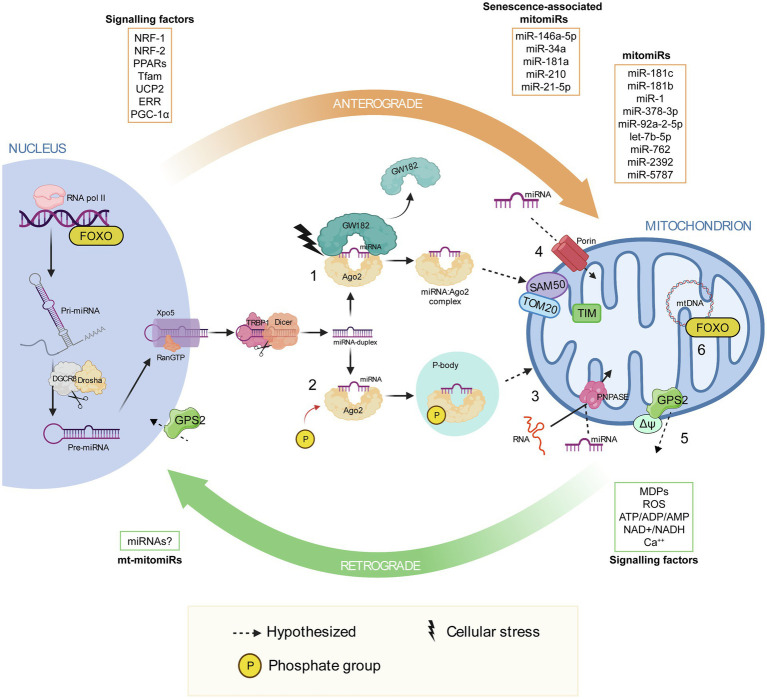Figure 1.
Mitonuclear communication with a focus on the proposed mechanisms of miRNA import into mitochondria. Mitonuclear communication plays a key role in mitochondrial homeostasis. The nucleus coordinates a number of mitochondrial functions through the so-called anterograde signaling, which involve various signaling factors, including nuclear-respiratory factor 1, nuclear-respiratory factor 2, peroxisome proliferator-activated receptors, mitochondrial transcription factor A, uncoupling proteins, ERR and PPARγ co-activator 1α. MicroRNAs have been observed in this communication network, some are transported into the mitochondria (mitomiRs) and a few of which are associated with cellular senescence associated-mitomiRs. At the same time, mitochondria communicate their functional and oxidative state to the nucleus via the retrograde response, which involve mitochondria-derived peptides and metabolites, such as ROS, ATP/ADP/AMP, NAD+/NADH and Ca2+. After their biogenesis in the nucleus and their translocation in the cytosol, miRNA duplexes are unwound, they bind to the Argonaute protein 2 (Ago2) and are loaded into the RNA-inducing silencing complex. (1) Due to cellular stress GW182 dislocates from RISC, leaving the miRNA:Ago2 complex free in the cytosol. It has been proposed that miRNA:Ago2 might be imported into mitochondria through the SAM50 and TOM20 pores in the outer membrane and TIM in the inner mitochondrial membrane (Jusic and Devaux, 2020). (2) Phosphorylation of Ago2 induces miRNA:Ago2 intake into a P-body, which is known to interact with mitochondria. (3) Translocation of miRNA:Ago2 complex into mitochondria may be supported by polynucleotide phosphorylase. Polynucleotide phosphorylase facilitates mRNA import into mitochondria, by binding to stem loop motifs in the RNA sequence. (4) Porins participate in miRNA translocation into mitochondria, as proposed by Bandiera et al. (2013). (5) After mitochondrial depolarization, GSP2 translocates into the nucleus, triggering the expression of genes involved in mitochondrial homeostasis. (6) Upon sensing stress stimuli in the mitochondrion, Forkhead box O can induce specific sets of nuclear genes, including autophagy effectors and antioxidant activators. Parts of the figure were realized using BioRender (http://biorender.com).

